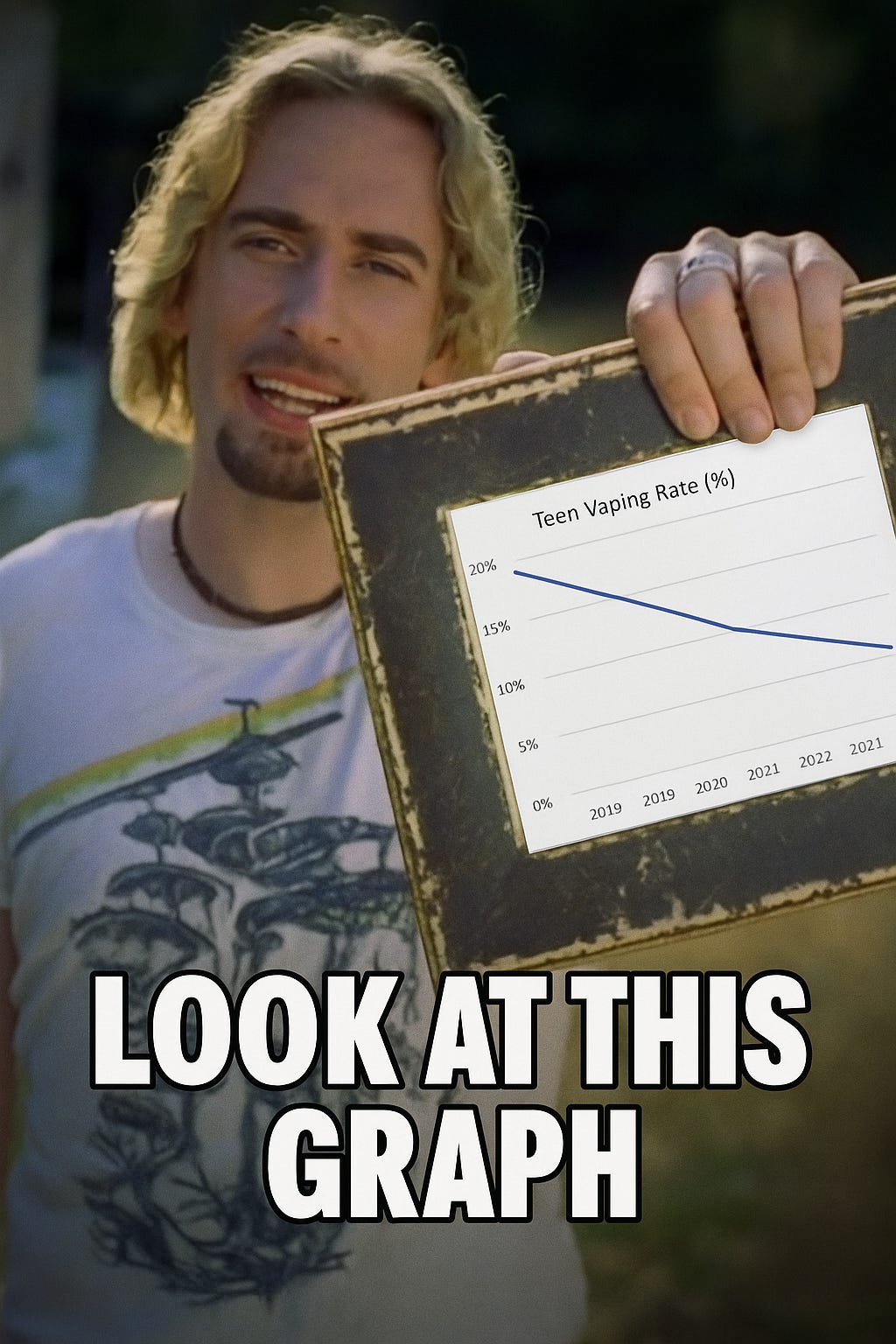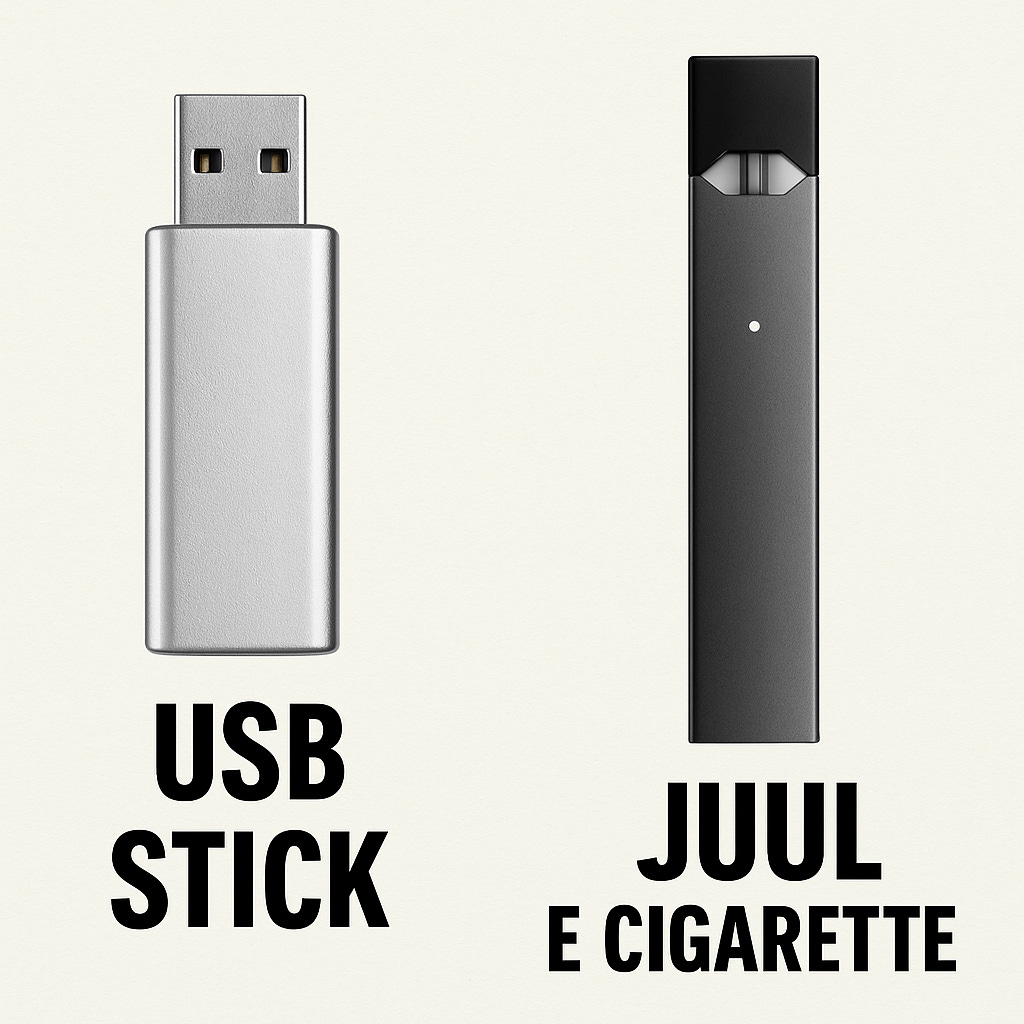The Teen Vaping Backlash: What Actually Happened and What We Got Wrong
A realist look at how well-intended policies turned a youth health crisis into a regulatory mess
In What The Realist Ledger Is—and Why It Exists, we mentioned the teen vaping saga as a perfect case study in panic, policy, and overcorrection. It’s time to unpack that mess.
Let’s be clear: teen vaping exploded in the late 2010s. By 2019, nearly 20% of U.S. high schoolers were vaping regularly.1 That’s a problem. We’re not here to debate whether something should’ve been done. It should’ve. And something was done. But the way it was done? The laws, the bans, the bureaucratic chokeholds? That’s where things went sideways.
This is a retrospective on vape policy—not a defense of Juul ads on Snapchat or Watermelon Ice puff bars in gym class. It’s a look at how a very real problem triggered a wave of policies that might’ve overreached, missed the mark, or created new problems entirely.
What the Numbers Say Now
In 2019, youth vaping hit a peak: 27.5% of high schoolers reported current e-cigarette use. Fast-forward to 2024, and that number has plummeted to 5.9%, according to the National Youth Tobacco Survey. Middle schoolers? Just 2.2%. Cigarette smoking is nearly dead among teens at just 1.4%.2
The headline: the policies worked—if we define success purely by the drop in youth usage.
But that’s not the whole story.
Vaping Wasn’t Always for Teenagers
Before “vape” became a verb for middle schoolers, it was a grassroots solution for adult smokers trying to quit. Early e-cigarettes were clunky, expensive, and extremely not stealthy. Think: flashlight-sized mods, tanks or RDAs, and DIY coil builds.
These setups cost real money. You needed a battery charger, tools, and basic electrical knowledge. They were a hobby, not a trend. They kept teens out by sheer inconvenience.
Then came convenience.
The Rise of Salt Nic and Disposable Culture
Salt nicotine changed everything.3 Unlike freebase nicotine (the harsh stuff), salt nic allowed high concentrations of nicotine to be inhaled smoothly. Juul capitalized on this with a sleek, USB-like device that delivered fast, cigarette-like hits without the fuss.
Then came disposable vapes—no buttons, no refills, no commitment. Just inhale and hide it in your hoodie. $10 or less and available anywhere from gas stations to TikTok resellers.
That’s when teen usage skyrocketed.4
How Each Party Responded
Democrats: Ban First, Figure It Out Later
National and state Democrats pushed flavor bans, tightened FDA oversight, and championed the PMTA process.5
California redefined vape gear as tobacco products—batteries, mods, and all—by stuffing it into a bill about raising the smoking age.
Their approach crushed youth vaping rates. But it also crushed the legal, adult vape market.
Republicans: Adults Shouldn’t Suffer for Teen Stupidity
GOP-led states mostly resisted flavor bans and favored harm-reduction messaging.
They supported adult access to nicotine alternatives and opposed sweeping regulation.
But weak enforcement meant black-market disposables flooded stores, often unregulated and sometimes unsafe.
Policy Blunders, Side Effects, and Regulatory Overreach
The PMTA Process Was Built for Cigarettes, Not Innovation
It requires costly, exhaustive applications—often millions of dollars—just to stay on the market.
Only Big Tobacco could afford it. Smaller, grassroots vape companies got priced out.
Flavor Bans Didn’t Just Hit Teens—They Hit Adults Trying to Quit
Menthol and tobacco flavors dominated what remained. Everything else? Gone.
Adults who quit cigarettes using fruit flavors either went black-market or gave up and returned to smoking.6
The Gray Market Boomed
With legal access limited, a tidal wave of knockoff Puff Bars and cheap disposables entered the scene, many imported from China.
Some were found to contain contaminants, while others evaded nicotine caps or ID checks.7
Zyn: The New Loophole
With vapes under fire, nicotine pouches like Zyn gained traction.8
Flavored, discreet, and lightly regulated, they became the second most-used product among youth.
California’s Law Was a Trojan Horse
Lawmakers buried sweeping changes to the definition of “tobacco products” inside a popular age-restriction bill.
Mods, batteries, even chargers got regulated as tobacco products. Most consumers didn’t even realize it had passed.
So, Was the Crackdown Justified?
Yes—if your only metric is youth vaping rates.
But here's where it gets messy: those same policies that helped push teen vaping down also slammed the brakes on adult harm reduction. Adults looking to quit smoking were suddenly caught in the regulatory crossfire.
While the science is still evolving, the consensus is clear: exclusive vaping is significantly less harmful than smoking. Smokers who fully switch tend to see better respiratory health and lower exposure to toxins. But with flavor bans, sky-high regulatory barriers, and shrinking legal options, many adults were nudged back toward cigarettes—or toward unregulated black-market vapes.
That’s not public health. That’s regulatory collateral damage.
So why did the policy feel like prohibition 2.0?
Because in some ways, it was.
The Realist Fix
Let’s drop the moral panic. Try this instead:
Real Age-Gating: Biometric ID, not just a checkbox.
Ban the Sneaky Stuff: No more 10 dollar disposables with sky-high nicotine content or devices under a certain size.
Leave Adults Alone: Refillable open systems? Not the problem.
Streamline the PMTA: Tailor it for vaping—not 1950s-style tobacco.
Watch the Loopholes: Zyn is getting away with a lot.
Who’s Doing It Right?
Dr. Brian King, former head of the FDA’s tobacco division, might be the closest thing to a realist in the room. He balanced crackdowns on sketchy marketing with acknowledgment that vaping can be a harm reduction tool.9
Naturally, his office was underfunded.10
Final Puff
We’re not denying there was a problem. Teen vaping in 2019 was real—and needed to be addressed. But what followed wasn’t just enforcement. It was overcorrection. Regulation built for optics, not outcomes.
We replaced one problem with another: a legal market handed to Big Tobacco, a black market full of mystery juice, and adults who just wanted to quit left in the cold.
If we want to protect teens and help adults quit, we need policies rooted in science, not fear. That’s realism.
If you found this useful, frustrating, or just better than the average moral panic piece—share it, like it, and help us get the algorithm to do something realistic for once.
U.S. Food and Drug Administration. “Results from the Annual National Youth Tobacco Survey.” FDA, Jan. 2025, www.fda.gov/tobacco-products/youth-and-tobacco/results-annual-national-youth-tobacco-survey.
Centers for Disease Control and Prevention. “Tobacco Product Use Among Middle and High School Students — National Youth Tobacco Survey, United States, 2024.” MMWR, 17 Oct. 2024, www.cdc.gov/mmwr/volumes/73/wr/mm7341a2.htm.
“Effect of Exposure to e-Cigarettes With Salt vs Free-Base Nicotine.” PubMed Central, 2021, https://pubmed.ncbi.nlm.nih.gov/33433597/.
Juul Labs. “Statement on 2024 National Youth Tobacco Survey Results.” Juul Labs, 6 Sept. 2024, www.juullabs.com/2024-national-youth-tobacco-survey-results/.
Vaping360. “State Legislatures Considering Over 30 Flavor Ban and PMTA Registry Bills.” 10 June 2025, vaping360.com/vape-news/8375/state-legislatures-considering-flavor-ban-and-pmta-registry-bills/.
Americans for Tax Reform. “Vaping & Tobacco Harm Reduction: 2023 Report.” 2023, atr.org/wp-content/uploads/2023/04/Tholos2023VapingTobaccoHarmReductionReport.pdf.
“What Are Carts? Breaking Down the Dangers of Black Market Vapes.” The Springboard Center, springboardcenter.org/what-are-carts/.
“Increase in Nicotine Pouch Use Seen Among US High School Students.” Pulmonology Advisor, 30 Apr. 2024, www.pulmonologyadvisor.com/news/increase-in-nicotine-pouch-use-seen-among-u-s-high-school-students/.
Filter Magazine. “Ex-FDA Tobacco Head Brian King Joins Campaign for Tobacco-Free Kids.” Filter, 6 May 2025, filtermag.org/fda-brian-king-campaign-tobacco-free-kids/.
NACS. “AP: FDA Chief Tobacco Regulator Brian King Removed From Post.” NACS Magazine, 8 Apr. 2025, www.convenience.org/Media/Daily/2025/April/2/4-AP-FDA-Chief-Tobacco-Regulator-Removed_GR.






